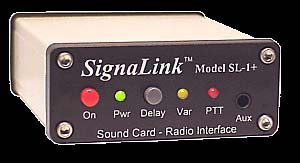
SignaLink USB Interface
Everyone knows that I am fascinated with computers, and radios. So what better way to enjoy the hobby than to work modes involving both computers and Amateur Radio at the same time? That’s right; I’m talking about computer generated modes using a soundcard-to-rig interface.
Have you ever heard of PSK-31? Slow Scan TV? Digital Slow Scan TV? RTTY? JT65A? There are tons of different digital modes that are becoming more and more popular. Let’s say you want to work extremely weak, distant, stations using 5 watts, or less, on PSK-31. Maybe you want to exchange some photos with your Ham Radio buddies using Slow Scan TV! Or maybe you want to try something really challenging, like Meteor Scatter, or EME (Moonbounce), by using some of the weak signal modes like JT65A or FSK441.
These modes, and soundcard interfaces, are becoming extremely popular. The technology combined with more sensitive receivers and audio components are making the once impossible – possible. For example, up until recently, EME (Moonbounce) has been an exotic mode that was usually reserved for the rich. After all, to bounce your signal off the moon’s not-so-reflective surface at 250,000 miles away in space – you had to have a highly directional array of antennas and a lot of POWER. Now all you need is a single 2 meter Yagi antenna, a good 100 watt transceiver, computer, and soundcard interface. The extremely weak signal mode JT65A has allowed many more average Ham Radio users to operate EME.
Now for those interested in buying an interface, I recently I purchased a SignaLink USB from Tigertronics. It’s a very compact unit (See Photos) and is very simple to set up. When I ordered the unit, I was told that I needed to select the radio cable from a list of compatible rigs. I selected the cable, and placed my order. (Total was around $100 bucks)
The unit came in the mail about 7 weeks later. That’s right; this thing is in such demand that they can’t build them fast enough. Anyway it came provided with very detailed, and easy to understand, instructions. I had to open the unit by removing 4 allen wrench type screws from the front faceplate. I then had to set jumpers according to the instructions. I reattached the front faceplate, and plugged in the two cables… That’s it! Windows XP immediately recognized the unit, and installed the necessary drivers. No installation CD’s or DVD’s necessary!
The instructions provided me with further details about setting my audio levels for optimum performance. The Signalink USB software is bundled with utilities for working Radio-Linking (Echo Link), PSK-31, MT-63, SSTV, APRS, Packet, RTTY, MFSK, ASCII, CW, AMTOR…etc.
The SignaLink USB interface has worked very well so far. I would recommend it to the advanced users, as well as the newcomers. The SignaLink USB has several advantages over most soundcard interfaces – such as my Rigblaster Plus. Here are some of the advantages that I’ve noticed so far:
1 – SignaLink uses its own internal soundcard, rather than the computer’s internal soundcard. By using your computers internal soundcard, you may have some minor interference due to the close proximity of your computer’s electronics. By using the external soundcard, you are less likely to receive this interference – making weaker signals more workable. (Most laptops come with a crummy soundcard)
2 – USB powered (No A/C power adapter needed, and no need to tie up your computer Serial Port)
3 – Basic Simplicit
4 – External Audio Controls (Set and forget, regardless of which computer you are using.) 5 – Size/Weight (Portability – this thing is light, and small. Perfect for backpacking.)
I hope this will encourage others to experiment as I did. A Rig-to-Soundcard interface provides you, as an Amateur Radio Operator, a whole new level of capability. If you need any help setting up a rig interface for your station, please don’t hesitate to give me a call or shoot me an email at: Timgreen@classicnet.net . I will be glad to help! (QRZ? ?) For more information on the SignaLink USB – check out their website at :
WWW.TIGERTRONICS.COM 73, ES GUD DX. DE KD5YPC (Tim)
Read More About Resonant Frequency: The Amateur Radio Podcast At www.rfpodcast.info
Check out our Glossary of Amateur / Ham Radio Terms used on the shows HERE
